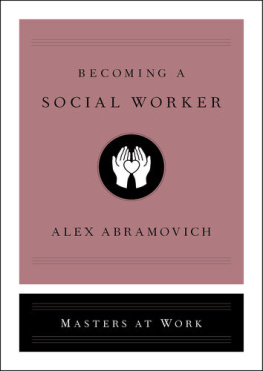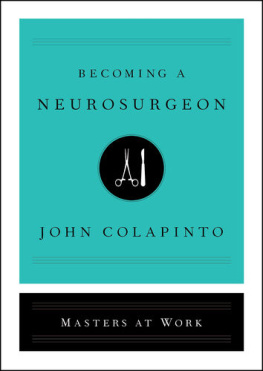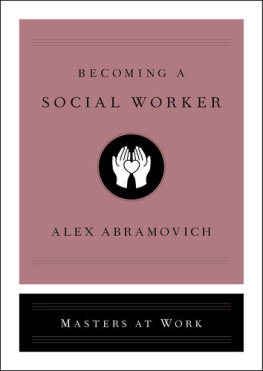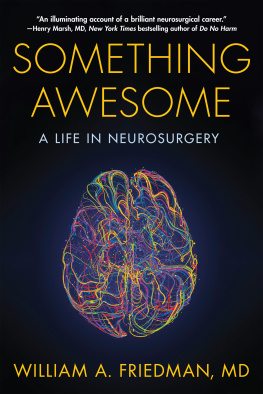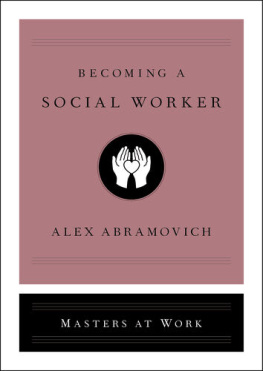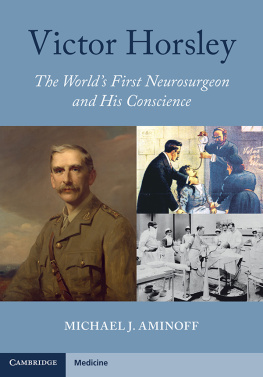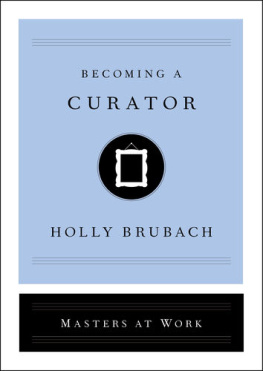B ECOMING A N EUROSURGEON
B ECOMING A V ETERINARIAN
B ECOMING A V ENTURE C APITALIST
B ECOMING A H AIRSTYLIST
B ECOMING A R EAL E STATE A GENT
B ECOMING A M ARINE B IOLOGIST
B ECOMING AN E THICAL H ACKER
B ECOMING A L IFE C OACH
ALSO AVAILABLE
B ECOMING A Y OGA I NSTRUCTOR
B ECOMING A R ESTAURATEUR
B ECOMING A P RIVATE I NVESTIGATOR
B ECOMING A B AKER
B ECOMING A S OMMELIER
B ECOMING A C URATOR
B ECOMING AN A RCHITECT
B ECOMING A F ASHION D ESIGNER

Simon & Schuster
1230 Avenue of the Americas
New York, NY 10020
www.SimonandSchuster.com
Copyright 2019 by Simon & Schuster, Inc.
All rights reserved, including the right to reproduce this book or portions thereof in any form whatsoever. For information, address Simon & Schuster Subsidiary Rights Department, 1230 Avenue of the Americas, New York, NY 10020.
Certain names have been changed, including those of all patients, as have certain identifying characteristics.
First Simon & Schuster hardcover edition April 2019
SIMON & SCHUSTER and colophon are registered trademarks of Simon & Schuster, Inc.
For information about special discounts for bulk purchases, please contact Simon & Schuster Special Sales at 1-866-506-1949 or .
The Simon & Schuster Speakers Bureau can bring authors to your live event. For more information, or to book an event, contact the Simon & Schuster Speakers Bureau at 1-866-248-3049 or visit our website at www.simonspeakers.com.
Illustrations by Donna Mehalko
Library of Congress Cataloging-in-Publication Data
Names: Colapinto, John [date], author.
Title: Becoming a neurosurgeon / John Colapinto.
Description: New York : Simon & Schuster, [2018] | Series: Masters at work
Identifiers: LCCN 2017022619| ISBN 9781501159176 (hardcover) | ISBN 9781501159190 (e-book) | ISBN 9781501159183 (trade paperback) Subjects: LCSH: Nervous systemSurgery. | NeurosurgeonsTraining of.
Classification: LCC RD593 .C592 2018 | DDC 617.4/80076dc23
LC record available at https://lccn.loc.gov/2017022619
ISBN 978-1-5011-5917-6
ISBN 978-1-5011-5919-0 (ebook)
T O D ONNA AND J OHNNY

Neurons
I t is 8:33 a.m. and Dr. Amir Madani, a neurosurgery resident at Mount Sinai, the large teaching hospital on Manhattans Upper East Side, is about to perform the final operation in his training as a brain surgeon. A team of doctors and nurses, eight people in all, dressed in blue scrubs and white paper face masks, move around Operating Room #2, preparing equipment, as the patient, a forty-year-old African-American woman, is wheeled in on a gurney. She is transferred onto an operating table in the center of the room, and the anesthesiologist inserts an IV needle into her right arm. He begins a drip of propofol, a powerful sedative. Within seconds, she is unconscious. A nurse, standing between the patients legs, places a catheter to drain urine during what is expected to be a four-hour-long operation. The scrub nurse arranges instrumentsscalpels, forceps, spongeson a large table beside the bed. Once all is in readiness, the neurosurgery resident, Dr. Madani, a tall, sad-eyed man in his late thirties, ties a surgical mask over his face and steps over to the sleeping patient.
Okay, he says, lets do this.
Neurosurgery residency, the training period for brain surgeons after their four years of medical school, is the most grueling in all of medicine. Trainees work upward of 120 hours a week, often on as little as one or two hours of sleep a night. They do this for seven years, the longest of any surgical specialty. This will be Madanis 1,807th operation at Mount Sinai, and his 180th assisting Dr. Joshua Bederson, the chairman of the department of neurosurgery.
It is a remarkable case on which to be going out. The patient had been in an accident six months earlier, hit in her car by a pickup that tried to swerve around her at a red light. A minor case of whiplash prompted a CT scan of her head and neckwhich revealed, serendipitously, a massive brain tumor the size of a mans fist in her left frontal lobe, just above the eye. The tumors spherical, self-contained shape suggested that it was of a slow-growing type that had, in all likelihood, been expanding for decades. The tumor now threatened to crowd out the healthy tissues (which have little room to expand within the closed box of the skull), inducing swelling that could cause her brain, squeezed like toothpaste in a tube, to herniateto push out through the hole where her skull joins the spine. This would crush the brain stem, the seat of such vital functions as breathing and heartbeatinstantly killing her.
Three months ago, in early March, Bederson, with Madani assisting, had eliminated the immediate danger to the patient by opening her skull, cutting a tiny two-centimeter slit in the surface of the brain, and decompressing the tumor by draining it of a watery yellow liquid that had been building up. They then removed the growth. Such tumors, however, are encapsulated in a thin skin or rind. The patient was now scheduled to have that rind removed, since a biopsy showed that it contained pre-cancerous cells.
The patient had, in the meantime, undergone a complete transformation. For her entire adult life, she had been antisocial, depressed, lethargic, spending the better part of the previous twenty-three years on the sofa watching television. In the months since that first operation, she had begun rising early to exercise and had shed fifty pounds. She now took intense pleasure in every aspect of her lifeespecially her two children, seventeen and fourteen years old, for whom she had performed parental duties like preparing meals but from whom she had been emotionally isolated and distant. She could now barely restrain herself from constantly kissing and touching them, as if discovering them for the first time. She felt the same way about her husband. They had met when she was eighteen years old and fallen in love, but she had shown little real affection toward him since 1996, when they married.
Neurosurgeons have long known about the changes in mood and personality that can take place through manipulation of the frontal lobes, but rarely does a patient show so dramatic a change in temperament and outlook as had occurred in this caseespecially so soon after treatment. While coming out of the anesthetic after the initial operation, she began laughing and pointing at the anesthetist and loudly, playfully proclaiming, I know you! I know you! The surgical staff dubbed her The Giggler because of her infectious, easily triggered laugh. At the time of her second surgery, to remove the tumor lining, she was making plans to enroll in nursing school. She had given up coffee, after a decades-long addiction, and wine. She no longer watched TVtoo busy exercising, talking, reading, living . Old texts on her smartphonemessages filled with bitterness, despair, and deep pessimismmystified her. I dont know who that person is, she said, before going into the second operation. I know it was me, but it doesnt seem possible.
I N THE OPERATING ROOM Madani tapes a pair of latex-free plastic strips over the patients eyes. He talks as he works. There is a fascinating account of frontal lobe surgery in Penfields letters, he says, referring to Wilder Penfield, the early-twentieth-century physician recognized to be one of the grandfathers of modern neurosurgery. In the late 1920s, he operated on his sister and removed a frontal lobe tumor. After doing the routine post-op tests in the hospital, he said, Oh shes doing really well. But later, he was at her house and saw that the place was incredibly messy, she couldnt manage two things at a time. She was confused, disoriented. Shed always been meticulously organized. He realized that the frontal lobe is extremely important, but mysterious. Almost a century later, were still so ignorant about what the frontal lobe does or how it does it.

